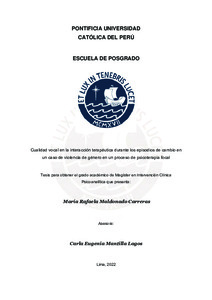| dc.contributor.advisor | Mantilla Lagos, Carla Eugenia | |
| dc.contributor.author | Maldonado Carreras, María Rafaela | |
| dc.date.accessioned | 2023-05-09T01:22:03Z | |
| dc.date.available | 2023-05-09T01:22:03Z | |
| dc.date.created | 2022 | |
| dc.date.issued | 2023-05-08 | |
| dc.identifier.uri | http://hdl.handle.net/20.500.12404/24915 | |
| dc.description.abstract | El psicoanálisis es considerado como the talking cure y con el pasar de los años, el
psicoanálisis relacional ha dado mayor énfasis a lo que sucede en el vínculo como
generador y promovedor del cambio, más allá de lo verbal (Aron, 1996; Coderch, 2018).
Así, parte relevante del vínculo es la interacción a nivel implícito que se despliega por
medio de diversos registros, que dan cuenta de la sintonía y regulación. Uno de los más
novedosos el de las cualidades vocales, que se refieren a la impresión perceptiva que
genera la voz y entonación en el oyente (Fernández, 2015). Por ello, esta investigación
tuvo como objetivo describir los patrones de cualidad vocal presentes en la diada
terapéutica, generando patrones de secuencia interaccionales vocales y analizar la
manera en la que acompaña el cambio subjetivo de una paciente víctima de violencia de
género. Para este fin se utilizó el instrumento de Patrones de Cualidad Vocal versión 2
(Tomicic, et al. 2015) para identificar y analizar los patrones en los episodios de cambio
identificados por medio del sistema de ICG de Krause y colaboradores (2006). Se utilizó el
material de audio y las transcripciones para poder realizar un análisis cualitativo para
identificar patrones secuenciales de interacción vocal y poder analizar el lugar que tiene en
el cambio. Los hallazgos dieron cuenta que si bien lo verbal es relevante para el trabajo
analítico y el cambio, si es que viene acompañado de cierta sintonía y regulación implícita
desde el vínculo con el terapeuta, los indicadores de cambio serán mayores. Asimismo,
más allá de la expertise del terapeuta, la competencia terapéutica tendrá que ver con la
capacidad del terapeuta para sintonizar, contener y sostener las necesidades del paciente
desde un lugar de receptividad y cuidado. En casos de víctimas de violencia de género, los
hallazgos demuestran que las interacciones a nivel implícito permitirán identificar el afecto
emergente y que este tipo de consultantes necesitará un terapeuta sumamente cuidadoso
y atento a los movimientos que se desplieguen del vínculo | es_ES |
| dc.description.abstract | Psychoanalysis is considered the talking cure and over the years, relational psychoanalysis
has place greater emphasis on what happens in how change is generated and encouraged,
beyond the verbal (Aron, 1996; Coderch, 2018). Thus, a relevant part of the link is the
interaction at an implicit level that is displayed through various canals, which account for
the harmony and regulation. One of the most innovative is vocal qualities, which refers to
the perceptive impression generated by the voice and intonation in the listener (Fernández,
2015). Therefore, this research aimed to describe the patterns of vocal quality present in
the therapeutic dyad, the development of vocal quality present in therapeutic dyad and the
interactional sequence patterns. This led to analyzing the way in which it accompanies the
subjective change of a patient, who is a victim of gender violence. For the purpose, the
vocal quality patters instrument version 2 (Tomicic et al, 2015) was used to identify and
analyze the patters in the episodes of change identified through the ICG system of Krause
et al (2006). Audio material and transcripts were extracted to make a qualitive analysis to
identify sequential patterns of vocal interaction and to analyze its place in change. The
findings realized that although the verbal is relevant for analytical work and change, if it is
accompanied by a certain tune and regulation from the bond with the therapist, the
indicators of change will be greater. Likewise, beyond the therapist’s experience,
therapeutic competence will have to do with the therapist’s ability to tune in, contain, and
sustain the patient's needs from a place of receptivity and care. In case of victims of gender
violence, they will demonstrate that interactions at an implicit level will allow the
identification of emerging affection and that this type of patient will need a very careful and
attentive therapist to the movements that will be used in the bond. | es_ES |
| dc.language.iso | spa | es_ES |
| dc.publisher | Pontificia Universidad Católica del Perú | es_ES |
| dc.rights | info:eu-repo/semantics/openAccess | es_ES |
| dc.rights.uri | http://creativecommons.org/licenses/by-nc/2.5/pe | * |
| dc.subject | Psicoanálisis | es_ES |
| dc.subject | Voz | es_ES |
| dc.subject | Proceso psicoterapéutico | es_ES |
| dc.subject | Violencia contra la mujer | es_ES |
| dc.title | Cualidad vocal en la interacción terapéutica durante los episodios de cambio en un caso de violencia de género en un proceso de psicoterapia focal | es_ES |
| dc.type | info:eu-repo/semantics/masterThesis | es_ES |
| thesis.degree.name | Maestro en Intervención Clínica Psicoanalítica | es_ES |
| thesis.degree.level | Maestría | es_ES |
| thesis.degree.grantor | Pontificia Universidad Católica del Perú. Escuela de Posgrado. | es_ES |
| thesis.degree.discipline | Intervención Clínica Psicoanalítica | es_ES |
| renati.advisor.dni | 09872386 | |
| renati.advisor.orcid | https://orcid.org/0000-0003-1112-479X | es_ES |
| renati.author.dni | 74423720 | |
| renati.discipline | 313127 | es_ES |
| renati.juror | Marinelli , Francesco | es_ES |
| renati.juror | Mantilla Lagos, Carla Eugenia | es_ES |
| renati.juror | Vasquez Torres, Gabriela Milagros | es_ES |
| renati.level | https://purl.org/pe-repo/renati/level#maestro | es_ES |
| renati.type | https://purl.org/pe-repo/renati/type#tesis | es_ES |
| dc.publisher.country | PE | es_ES |
| dc.subject.ocde | https://purl.org/pe-repo/ocde/ford#5.01.00 | es_ES |







